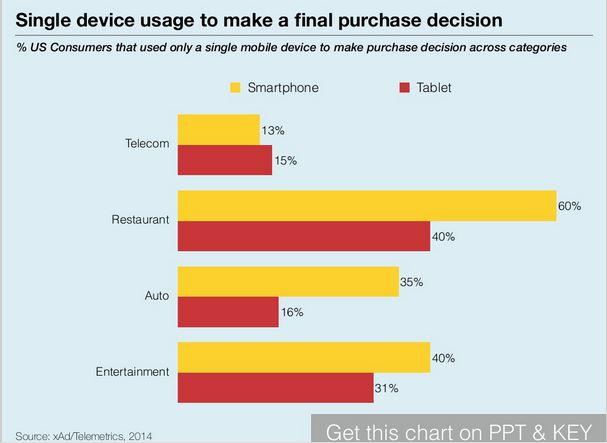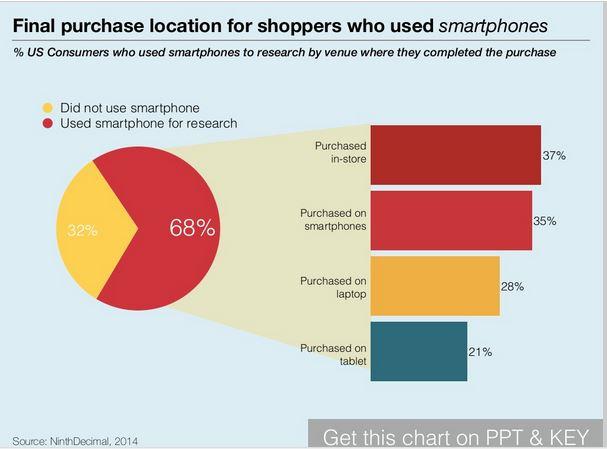US shoppers behavior changes 2014 report presents a trend that I noticed a few years ago. We are using more and more mobile phones, smart phones and tablets in our purchasing journey.
I found a great report : Mapping the US Shopper’s Mobile Path to Purchase prepared by DNC recently.
Please find below the most important findings:
- In 2014, 29% of US consumers said smartphones were the most important shopping tool up from 23% in 2013.
- 42% of consumers consider a mobile device as the most important resource for a purchase decision just behind laptops and desktops at 43%.
- 60% of US consumers claim to have used only their smartphones when deciding which restaurant to visit.
- 40% of US consumers claim to have used only smartphones when deciding on their choice of entertainment.
- 35% of US consumers say they used only smartphones when deciding on which car to buy.

- 68% of US consumers conduct pre-purchase research on their smartphones at some point in their purchase journey.
- Among US consumers who research on their smartphones, 37% make the final purchase in a store followed by 35% who make the final purchase on their smartphones.
- 67% of US consumers conduct pre-purchase research on their tablets at some point in their purchase journey.
- Among consumers who use tablets for research, 41% end up making the final purchase on tablets, 33% make the final purchase in store, and 32% use the laptop to make the final purchase.

- 74% of US consumers conduct pre-purchase research on their laptops at some point in their purchase journey.
- Among consumers who use laptops for research, 52% make the final purchase on laptops followed by 37% who make the final purchase in store and 21% use their tablets to make the final purchase.
- 60% of US shoppers conducted research in stores.
- Among the store researchers, 57% end up buying from the store compared to 29% who buy from their laptops.
- 53% of US smartphone using shoppers accessed the device when inside their homes in 2014 up from 32% in 2013.
- 76% of tablet using shoppers accessed the device in their homes in 2014.
- 49% of entertainment shoppers used their mobile device to browse and see options.
- 48% of telecom shoppers and 47% of auto shoppers used their mobile device to browse and find options compared to 36% of restaurant shoppers.
- 58% of US shoppers prefer visiting retailer website for product discovery.
- 33% of US shoppers preferred to access retailer branded apps.
- Only 13% of US shoppers prefer to discover products and services through opt-in notifications and alerts.
- 72% of US consumers use their mobile devices to research electronic products.
- 57% of shoppers in the clothing category and 46% in the shoes & fashion accessories category use their mobile devices to research products.
- 46% of US consumers research household items on mobile devices and 45% research appliances to discover possible purchase options.
- 49% of telecom shoppers conduct in-depth research on mobile devices to narrow down their choices compared to 20% of restaurant goers.
- 61% of smartphone using shoppers and 50% of tablet using shoppers look up possible locations they can visit near them.
- 52% of shoppers access smartphones and 44% access tablets to look up directions to local stores.
- 41% of US shoppers accessed smartphones and 42% accessed tablets to look up reviews and decide on which store to visit.
- 38% of smartphone using shoppers and 32% of tablet using shoppers called local stores asking for information such as opening and closing times, availability of product, and on-going promotions before deciding to visit.
- 80% of consumers use mobile devices inside a store to enhance their shopping experience, up from 64% a year ago.
- The most popular way to use mobile devices while in-store is to comparison shop (59%) followed by searching for coupons (48%) and reviews (47%).
- Retail stores are the top business venue for consumer mobile usage accounting for 31% of mobile connections followed by restaurants (21%), service-related venues (19%) and financial institutions (15%).
- 28% of in-store mobile usage happens in clothing stores followed by convenience stores (18%) and specialty stores (12%).
- 52% of US consumers share retail related posts on social media.
- 51% of consumers visit social media platforms to post pictures of items they are interested to purchase.
- Only 18% of consumers visit social media sites to post videos of the products they are considering for purchase.
- On average, 62% of consumers who used a mobile device during the shopping process made a purchase. An additional 16% deferred purchase for a future date.
- 49% of smartphone using shoppers and 42% of tablet using shoppers complete their purchase within an hour or less of using their mobile device to start browsing for options.
- On average 65% of mobile using shoppers make a purchase on the same day they started browsing for possible options on the device.
- 23% of US shoppers who used their mobile device inside a retail store made a purchase on the device itself up from 12% a year ago.
- For both smartphones and tablets people are most comfortable spending $100-$249. Smartphones outpace tablets for purchases under $250, while tablets outpace smartphones for purchase over $250.
Consumer reviews authenticity is really important factor to build your business and consumers’ trust.
The below infografic from Baazarvoice presents very interesting data.
Simply it is better not to hide controversial or negative opinions than delete or hide them.
It is a business and sometimes it is so difficult to be prefect.
There are also some local legal regulations that don’t allow hiding such opinions or reviews like in European Union.
The US market is different. You can do what you want but the below data present that in long term it is not good for your business.
Consumer reviews authenticity
Consumers are more and more educated, knowledgeable. They use forums, portals, specific social media networks for sharing opinions. They also look for the trustworthy sources before they buy anything – like Amazon reviews, Angie list and others.
Consumers even want to see some trusted marks on websites or online shops like Trustedshops, BBB.org, Rzetelna firma (Polish) or others.
. Today I read an interesting article on HBR about negative feedback.
I don’t want to copy their thoughts but I would like to add my own ones.
Negative feedback
Currently we afraid about negative people, negative feedback, negative emotions, etc. I see it like a “positive trend” that it is not always a positive and good for us and our businesses. Of course there is another trend in social media and online media overall – haters…- people that hate everything, comment with anger, envy,etc. We can easily find such examples in our world.
On the other hand we forget about the constructive critique than brings development and changes our world in a positive way. All inventions come from a critique of a lack of some needs fulfillment and dreams.
I don’t think here about the straight critique of people’s work, talents or their traits that can damage a very fragile person and stop her/his development. It has to be done in a very tactful way. Everybody is unique with his/her skills, talents and experience. We have to respect each other but also constantly develop our skills. Young people should learn it especially. The competition is growing rapidly. They have to compete with all global generation that has similar skills and possibilities.
I think here about the critique of company processes, customer service, products.
The business consultancy is something like that – we look at the company’s issue and analyse, criticize and recommend solutions.
Our customers are our consultant very often. Simply we forget about it.
Recently I had a B2B client that lost his 70% customers. Of course he wanted to know why.
After small talks to his team, I got information that all his team members knew about this change half a year before their customers left. Can you imagine?
And they didn’t do anything to stop or find out why. The employees thought that their services/products are too expensive in comparison to the competition. But they didn’t ask straightforward their customers if they were satisfied or not.
This is the reason if your company gets the direct critique or feedback, it is a positive act.
Simply you can change something faster or prepare yourself for changes ( if they are long lasting like a needed investment). You can get loyal customers if you can help them and solve their problems.
If employees of the company that I described before shared the information and knowledge with his boss, they would prevent a situation of losing rapidly 70% of customers. Maybe they could change their products, price list, internal processes or prepare themselves for new ones, or postpone their leaving.You can imagine how difficult is to get new customers, how costly it is and time consuming in B2B service.
After my analysis we found out that not only too high price was the main issue.
There were others:
- lack of flexibility in solving issues
- poor customer service – answering after 24 hours; lack of nice atmosphere and simply chatting that customers needed
- lack of regular reviews of customer portfolio: most profitable customers, most demanding vs. cost, time spent
- lack of effort of getting new customers
- lack of regular promotions and marketing activities
- lack of investment in online tools that people prefer now
- and many others
My advice is to take a negative feedback from your customers as a gift. It can  show you an issue in your business very often before you can notice it in your financials and statistics.
show you an issue in your business very often before you can notice it in your financials and statistics.
Social marketing can help in getting some trends for your business if you plan a long term business. You can learn what people like, what is interesting, how to engage them, even they are not your customers now because of their age.
I see that the most important is your product and service. If you can excel and present it in a marvelous way, you will win. People love unique and great designed things. Look at Apple, Samsung, Boca do Lobo. They have all these parts plus great operational processes.
I wish you and myself to get to such level.:)
Content Marketing and Search Engine Optimization (SEO) are two critical components of inbound marketing. Recently I read a few interesting articles about it. These is a summary of my findings.
The larger the organization, the more challenging it is to get approval and buy-in to build a sustainable content marketing program that will significantly move the needle in SEO
Your content marketing strategy will provide the biggest boost to your organic search visibility if you follow these four rules:
1) Know your key personas
2) Know and write to all stages of the buy cycle
3) Talk outside-in vs. inside-out
4) All write in the same direction
Know Your Key Personas
We all know how important it is to know your customers, core audience and key personas on the web. This applies directly to the content you create – especially for B2B companies – that usually have a limited content creation budget.
The clearer the picture of your personas are, the more targeted your content creation will be resulting in higher quality visitors that are closer to your ideal prospect.
Simply answer following questions:
• What are the main types of business problems the persona typically needs to solve?
• How does your product or service provide solutions to these problems?
• What are some specific tasks the searcher wants to accomplish?
• What are some sample search queries the persona might use?
• What can the site provide that will cause the searcher to accomplish this task?
• What is your business goal for the visitor? Lead gen? Newsletter sign-up? Sale? Inspiration?
• How will the searcher be motivated to complete this business goal? i.e., what’s the offer or incentive? What is the call-to-action?
With this intimate knowledge of your audience in hand, you can craft more relevant keyword and content topics.
Know and write to all stages of the buy cycle
Here are the four main stages of the buy cycle to build content for and the appropriate types of format for each:
Author: Scott Fasser, VP of Customer Experience at Optify
Talk outside-in vs. inside-out
Knowing your key words that web users use via a search engine can help you drive a new way of your brand communication as well as modifying your basic message.
SEO helps reach more customers in an inexpensive way. If you don’t like words your clients find your company via search engine, you can invest your time and money into the keywords more relevant to you. But a wiser thing is to use what you have and create different communication by using your current key words.
The lesson here it to review your current and future messaging from the point of view of a persona that does not know about your brand, focus on true differentiation/value proposition and create content that they will understand without needing an explanation. Finding that balance between pushing new concepts and terms vs. serving the market where it exists today is an important input into your content marketing planning.
Write in the Same Direction
Content creation and SEO is no longer limited to the marketing department and copywriters. Blogs, social media, press releases, video, podcasting, etc. has created many ways to easily publish content to your company and other industry related sites. Profiles on Facebook, LinkedIn, Twitter, SlideShare, Pinterest, Google + mean that there are MORE places to fill with content. All of this communication impacts your brand and visibility – positively or negatively.
One of the most important things you can do to amplify your content strategy is to get as many people in your organization to understand how their work can impact the SEO program and what they should to contribute. By giving them the education and the game plan for what key messaging and keywords are reinforces the central promise of your business.
Simply one voice and one direction = you are the king.
Do we need a strategy? Do we need to have a market intelligence competency?
Yes, it is really important nowadays:
- strategy,
- tactics,
- detailed plan,
- fast implementation,
- fast reaction on changes
- and most boring – process analysis, testing and optimisation, and once again implementation into real operations
Is it a something more difficult than commercial creation or any promotional gadget preparation?
The answer is YES.
Why is it so important?
Because it gives a short and long term strength for your company.
Why is it so unique and most marketing agencies don’t want to propose it to its clients?
Because they want to present fast solutions for marketing departments – a beautiful commercial on the first page in newspaper. But what about customers? What do they need?
Yesterday I read a great article about Generation Y born 1980-1996 and “Cool brands stay hot”
It looks that not only me and my friends are overloaded with information, the same marketing tactics and push sales.
Digideo’s marketing strategy process looks very fast:
1. questions and questions – Every industry has its own specifics. Every company has a different situation – internally and externally, its age and development potentials. It means every company is unique and needs unique solutions:
- what you did previously? how?
- what results did you achieve from specific actions?
- how much is the new customer acquisition?
- what is the retention?
- how much does your client pay you in average?
- what is the cost of serving this customer? – it is a very rare knowledge. Simply many companies don’t know this cost. I can analyse it as well.
- what services you have?
- what services did you customer use more often?
- did you try to contact your previous customers that used your services?
- who else is in your environment? contractors, subcontractors, the supply chain, etc?
2. meeting with key employees
3. clarifying the goal and the scope of strategy after interviews
4. analyzing the situation: including competitors, SWOT
5. building strategy for particular goal with measures and KPI for processes
6. creating the high level strategy implementation plan = like a project plan with measures
It will take 2-4 weeks for small companies. For huge multinational companies – 2-3 months.
Why is it important to spend a time for it?
1. it gives you a direction, vision and knowledge about yourself and competition, environment around you
2. it sets goals and plan how to achieve them
3. it can look at your processes from outside and help in better performance, cost cutting for example
4. it will help in analyzing you current activities – ROI, efficiency, quality and result for company
5. and many others
MINUSES:
1. TIME – yes – you need to find a time for me, for this job
2. COST – yes – it costs
3. changing environment – yes – it has to be reviewed after a particular period of time – half a year or quarter.
